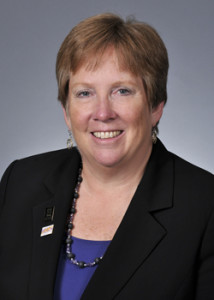By David Thill
With patient safety and population health at the forefront, Brody students gain the skills to become leaders in health systems management
Editor’s note: Sensing a gap between how physicians are educated and the future needs of the U.S. healthcare system, the American Medical Association in 2013 launched its “Accelerating Change in Medical Education” initiative. The association awarded grants to 11 medical schools to fund selected innovations in medical education, and then expanded the program in 2015 to an additional 20 schools. Here’s a look at one program shaping tomorrow’s physicians – and Repertoire readers’ customers of tomorrow.

Elizabeth Baxley
Healthcare has long been a hierarchical practice, with the doctor taking charge of his patients’ wellness, the rest of the team following. But as procedures advance, costs rise, and education evolves, professionals have come to realize that the most important person in the patient’s care is not the doctor; it’s the patient. Perhaps more importantly, the doctor often sees the patient only in the clinic, when really, the solution to their health may lie outside the doctor’s office.
In the fall of 2014, as part of the American Medical Association’s “Accelerating Change in Medical Education” initiative, Brody School of Medicine at East Carolina University in Greenville, N.C., implemented its Longitudinal Core Curriculum, joining the national movement bringing patient safety and patient-centeredness to the forefront of medicine.
The Longitudinal Core Curriculum focuses on “understanding the patient from their perspective,” according to Elizabeth Baxley, MD, senior associate dean for academic affairs at Brody. It brings patient safety together with quality improvement, interprofessional care, and population health, in providing students with a better understanding of health systems and methods to improve them.
“There are many [factors] that influence health outside the healthcare you receive,” says Baxley, whether socioeconomic, cultural, religious, etc. The Longitudinal Core Curriculum aims to teach students the importance of understanding their patients and how to work with them. Also, says Baxley, it teaches the importance of health officials being “community advocates,” facilitating such things as healthy eating initiatives and physical fitness activities within communities.
Integrated medical training
“We specifically did not want this to be just a new course or set of requirements,” says Baxley. Instead, the goal is to integrate the concepts throughout students’ training. “We want them to graduate thinking that this is how you do business.”
Students are introduced to the new curriculum in their first year of training – focusing on patient safety and patient- and family-centered care, among other concepts – and continue through their fourth and final year, when they transition to residency. Throughout that time, they complete virtual modules through the Institute for Healthcare Improvement’s Open School, eventually earning an IHI Open School certificate. These modules focus on several of Brody’s core subjects, including patient-centered care, and are a common curriculum component in many medical schools.
Brody has taken the training further by linking each module to practical hands-on activities. For example, one first-year module focuses on patient safety and the proper handling and disclosure of error in medical procedures. In the accompanying activity, students gather in small groups to learn about and analyze a specific case of procedural error, and how the involved healthcare team handled the situation.
Tomorrow’s leaders
Brody’s new curriculum also includes a distinction track, Leaders in Innovative Care, more commonly known as LINC. Comprised of ten students selected from a rigorous interview process during their first year, LINC scholars are considered future leaders in their chosen career paths.
They receive deeper training, particularly in management and leadership, than they would in standard medical training. This includes participating in activities such as “windshield tours,” during which they visit local communities and analyze where these communities stand from a health perspective. They look for factors that facilitate its health and those that make living healthy lives more difficult, says Baxley. For example, are walking trails or other fitness opportunities available for residents? Are there viable sources of healthy food?
LINC students also follow individual patients “from parking lot to parking lot,” examining both the care the patient receives, as well as the challenges they face in navigating the healthcare system.
“We’re already seeing that these students are stepping up and providing leadership,” says Baxley. For example, in January, the Brody School held its second annual Quality Improvement Symposium, in which students, residents, and faculty members submitted abstracts and proposals presenting “ways to better meet the demands of a changing health care delivery system,” according to the Brody website.
“Our number one podium presentation this year, focused on improving care for patients with sepsis, was presented by a LINC scholar,” a second-year medical student, says Baxley.
Minimizing error on a bigger scale
While it is still too early to see how students fare in their chosen career paths after experiencing Brody’s new curriculum, Baxley and her fellow faculty view it as training in the new competencies required for medical professionals to understand health systems in a changing field.
“The number one [idea] we’re trying to teach is about systems of care,” she says. “Errors of care are very rarely the result of somebody making a human mistake; errors are generally related to systems problems.”
With these concepts in mind, medical students at Brody will hopefully gain skills in understanding the many factors that contribute to error and the multiple ways of correcting errors; and, above all, to act as leaders and “speak up when they witness an error,” says Baxley.
David Thill is a contributing editor for Repertoire.